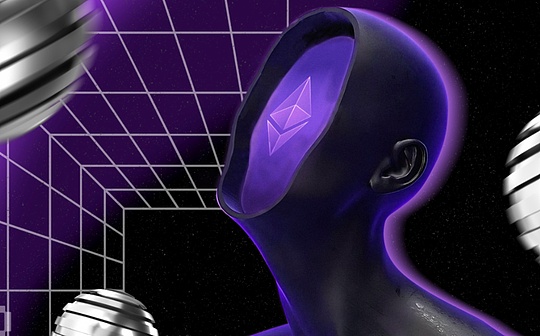
Author: Andrew Fenton Source: cointelegraph Translation: Shan Oppa, Bitchain Vision
Explained to the developerPectra Hard ForkConfused with technical terms?We interpret these upgrades for you in the language of ordinary people.
Recently, Ethereum’sExpanding roadmapCriticized by all parties, evenETH Researcher Dankrad FeistandBase founder Jesse PollakAlso believed thatThe existing expansion plans “lack of ambition” or even “far from radical enough”.
However, the community’s doubts seem to beIgnite the fighting spirit of some core characters.
Last weekend, Ethereum founderVitalik ButerinA new article was published,Call for accelerated expansion roadmapand to the current chunk of each blockData Availability Blobs (DA Blobs)from3 quickly increased to 128 and above.
L2 (Layer 2) Network dependency Blobs to store data,The more blobs, the lower the growth cost of L2.Therefore, accelerating capacity expansion is crucial to the entire Ethereum ecosystem.
at the same time,Crypto investment company Paradigm also released a proposal, the general meaning is: “Stop delaying and launching an expansion and upgrade now!”
on the other hand,Base, Arbitrum and OptimismL2 leaders have also reached a consensus that they shouldUnified ecological standards, in their respective projectsUse a universal or native Rollup solution.
So, Ethereum is comingPectra upgrade (expected to be implemented in March)How many expansions and improvements can it bring?What new features will it introduce to ordinary users?Let’s find out.

Pectra upgrade is divided into two parts
initial,Pectra Hard ForkPlan to become the history of EthereumThe largest upgrade,IncludeUp to 20 EIPs (Ethereum Improvement Proposal).But now, the upgrade has been split into two parts.
therefore,Pectra can only temporarily alleviate scaling problems, its main improvement is toThe number of data availability blobs increased from 3 to 6, only provides short-term relief to expand demand.
Mallesh Pai, Director of Research, ConsensysNote that“Six months ago, the ‘Double Blobs’ plan wasn’t even on the roadmap”, but even so, the upgrade still fails to meet the huge growing demands of the L2 network.
“Based on the current growth rate of L2, the effect of this upgradeAt most, it can only last until the end of this summer.”—Mallesh Pai
The good news is,Fusaka Hard ForkIt is expected to be implemented later this year or early next year, with a key upgrade:
Peer Data Availability Sampling (PeerDAS)——This will becomeThe most important change in Ethereum expansion, Vitalik Buterin also hopes that the entire community will focus on this.
PeerDAS: Torrent for Blobs
PeerDAS is the next evolution of the “Proto-Danksharding” technology, which allows L2 to store data in Blobs, avoiding competing for block space with L1 transactions.
However,EIP-4844 still requires Full Nodes to download all blobs for the entire block and verify the integrity of the data in it.
“This is extremely inefficient and poses a burden on small node operators. Downloading blobs (even in the case of a proposer) consumes a lot of bandwidth.”
——Emmanual Awosika (2077 Collective Research Director)
PeerDASOptimized ways of blobs data storage and verification, split it into smaller data chunks, similar toP2P Seed Download (Torrent), allowing different nodes to store and access only part of the data, rather than downloading full blobs.
Vitalik expects thatPeerDAS will immediately increase the number of blobs by 2 to 4 times, and even 8 times or more in the future.
Just nowLast week,Base founder Jesse PollakIt is also criticizing Ethereum’s existing roadmap for being too slow and saying“The original expansion target for 2027 should be advanced to 2026”.
But ifVitalik’s prediction is correct,SoPeerDAS may increase the number of blobs to 48/Slot within next year, significantly accelerate the expansion process of Ethereum.
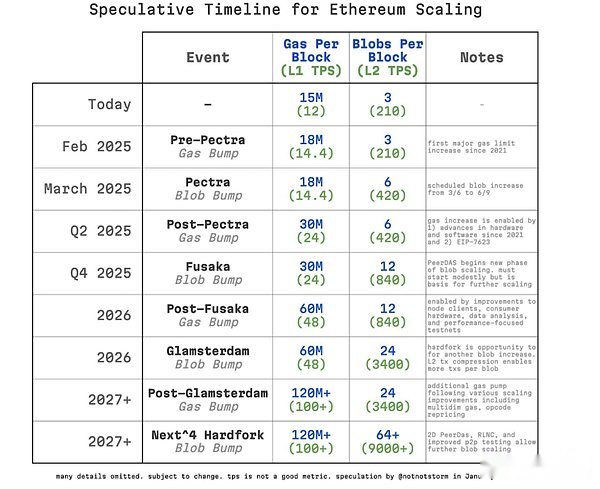
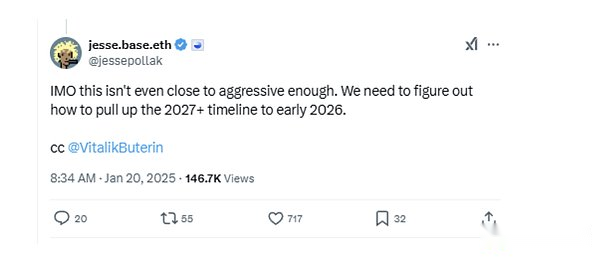
However,The improvements brought by Pectra upgrades are not just doubled in the number of Blobs,AwosikaIt is pointed out that there are two key changes:
-
Account Abstraction is applicable to all accounts
-
Maximum staking limit (staking Limit) adjustment
He said both changes were “major breakthroughs.”
In addition, there is a highly discussed proposalEIP-7623, it has not yet been determined whether it will be included in the upgrade.
“If EIP-7623 is finally implemented, further improvements to Gas Limit will be possible in the future – this will be a major breakthrough. As for other improvements, it will be more optimization and iteration.”
——Emmanual Awosika
Ethereum’s expansion roadmap suffersLots of bearish sentiment, in large part because:
Developers and researchers use a lot of complex terms and technical concepts when explaining, which makes most people simply unable to understand the actual impact of these upgrades.
Therefore, we try our best toPectra UpgradeTranslate the key content intoLanguage that ordinary investors can understand, help everyone truly understand the significance of this upgrade.
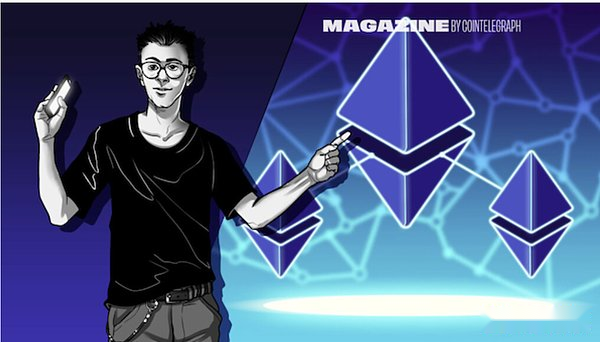
Everyone has a smart account (EIP 7702)
The biggest usability improvement implemented by Pectra is EIP-7702, which allows existing Ethereum accounts to be upgraded to smart accounts with just a click (also known as “account abstraction”).
This will ultimately solve the problem of “approval” and “exchange” in Ethereum transactions that have long been disliked.
It also supports “social recovery, native multi-signatures, and a variety of other features that allow us to bring a lot of new value and experience directly to our users,” Pai said.
If all this sounds familiar, it’s because smart accounts were already launched on Ethereum as early as early 2023 and achieved a brilliant success with ERC-4337.However, this is a workaround to avoid hard forks, requiring users to go through the painful process of starting a new wallet.At its peak, about 3.5 million wallets use it.
John Rising of Stackup, a smart account platform, explained: “Broad adoption is hindered by a critical limitation: users cannot upgrade their existing wallets to smart accounts.”
Incredibly, Pai said, Buterin came up with a more elegant solution in Pectra in less than an hour.
“I know he was on a hunting trip in Kenya, on a truck […] and came up with a route that everyone could follow and do. So, yes, he was amazing.”
By allowing for simple upgrades to existing wallets, Rising said, “we are removing the last major barrier to mainstream adoption of account abstraction.”
“The features we take for granted in traditional finance – automatic payments, account recovery, merchants’ handling of transaction fees – can eventually become the standard for Web3,” he said.
“We will see no pre-approved subscription services, gas fees paid in any token, biometric security that replaces seed phrases, autonomous agents that operate safely within the wallet, and seamless cross-chain interactions.”
While it all sounds great, the complex smart account functionality is relatively expensive on the L1.However, once the EIP-7702 is online on L2, the smart account feature can run seamlessly between the two.
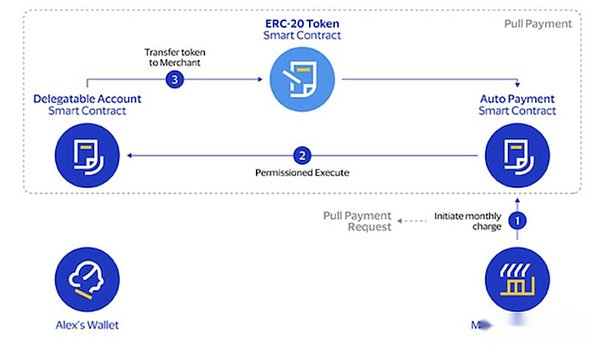
Validator pledge limit increased (EIP-7251)
A major improvement for the health of the network itself is to increase the maximum staking limit for validators from 32 ETH to 2048 ETH.
Currently, if you are lucky enough to have 2048 ETH and want to stake it all, you need to run 64 independent validators.Given that the same person controls ETH, this will put 64 times the pressure on the network than it actually needs, and there is not much benefit in decentralization.
“The resulting network overhead (every validator has to sign blocks, signatures have to be summed up, etc.) reduces the performance of the entire network,” Pai explains.
Awisoka says it crashes if millions of validators try to join the beacon chain, so raising the limit is a wise move.“This eliminates one of the root causes companies like Lido and Coinbase to run so many validators with few node operators.”
There are other benefits to reducing network overhead.“This upgrade unlocks other much-needed upgrades, like single slot finality,” Awosika said.Single slot finality allows for blocks to be raised and completed within 12 seconds (rather than 15 minutes), meaning transactions are confirmed almost immediately.“SSF is a big obstacle to Rollup interoperability,” he said.
Blob targets will double
As mentioned earlier, the blob target increases from 3 to 6 per block to help L2 scale.The maximum number of blobs is already 6, but whenever L2 publishes data that exceeds the target, the expenses soar and L2 becomes uneconomical.
“It’s been happening several times this month. Pectra increases the number of blobs per block to a maximum of 9, with a target average of 6. So that’s actually an increase of 100%” Pai explains.
That being said, increasing the number of blobs faster comes at the expense of increasing the block size and imposes higher bandwidth requirements on Ethereum individual stakeholders.The higher the requirements, the fewer pledges will be.
“In the coming year, the trade-off between the demand for Ethereum L2 and its decentralized core values will be a key theme for developers.”
Additionally, validators have been calling for increased gas targets to 36 million per block, which will help expand the underlying layer of Ethereum.It does not require a hard fork and is likely to be enabled immediately after the vote reaches 51%.
Blobs may increase further (EIP-7623)
EIP-7623 is under consideration, but it has not yet been confirmed for the application of Pectra upgrade.The proposal can increase the number of blobs per block to 18 by repricing the call data (this is the original method of storing data on Ethereum).
“If they do implement EIP-7623, it is possible to further increase gas restrictions in the future,” Awosika said.
The proposal essentially increases the gas cost of transactions using large amounts of call data to inspire them to switch to blobs.This makes call data and block size more predictable, meaning the network can safely increase the number of blobs without overloading the system.
Awosika explains: “If you can know what the maximum chunk size is (meaning: try to use rollups of calling data instead of blobs won’t blow up the blocks), then I think you can add more blobs with more confidence.”
Exit Ethereum Commissioned Pledge without permission (EIP-7002)
This is another complex upgrade that makes your ETH delegate staking more secure.It not only enhances Lido and RocketPool’s control over malicious node operators, but also enhances the ability of staking ETH token holders to withdraw funds without the permission of the node operator running the validator on their behalf.
Currently, you may encounter situations where you cannot withdraw the staked funds because you do not withdraw the required verification key.
“This is a bad practice, for the obvious reason, that is, someone can withhold your funds and refuse to agree to withdraw money,” Awosika said.
The new upgrade separates the validator key used by the node operator from the withdrawal key, which is kept by the ETH stakeholder.In this way, the pledger can restore the balance and withdraw money at any time.The pledger submits the request in the form of a regular transaction, and after some technical trouble, “the pledger can withdraw the money after the pledge funds are sent to the withdrawal address without the operator’s approval.”
The upgrade also benefits pooled staking agreements such as Lido and Rocketpool.“Currently, node operators funded by withdrawal addresses controlled by DAO can refuse requests to exit the validator or intentionally commit violations to trigger a staking ETH cut,” Awosika said.
“Protocol DAOs are helpless under the status quo, because these validators can only exit through the validator key controlled by the node operator. However, the EIP-7002 authorizes the DAO to force exit from one or more validators controlled by the malicious node operator.”

The extension won’t be done overnight, but it will definitely happen
Mallesh PaiIt believes that the community hopes to expand and improveIt is completely understandable to land faster——So he himself.
“Everyone hopes the upgrade will be completed immediately.”
“But these improvements will eventually come true.”——Pai
Joe Lubin, CEO of Consensys and Co-founder of EthereumIt means that Ethereum’s expansion roadmapActually much smoother than many people think.
“I don’t think the current progress is absolutely optimal, but overall I’m very satisfied with the current development.”
“While some people would think some aspects are not going well, I think the overall situation is still on track.”——Lubin
Lubin also pointed out thatUpgrade a public chain with a market value of US$400 billion (Ethereum)Need to be inspeedandSecurityKeep balance between.“We have to make sure that the network is not destroyed because it carries a huge value. At the same time, we also need to make sure that it is still sufficiently decentralized for users with certain device capabilities. So that’s always a trade-off that needs to be discussed.”
I personally support raising the hardware and bandwidth threshold for Ethereum, which I think is reasonable.As forPectra Upgrade, Pai thinks it isAn important advance, will help solve the problemThe problem that has long troubled the Ethereum ecosystem.After Pectra, the ‘interoperability’ and ‘fragmentation’ problems that plague users and developers will be easier to solve.








